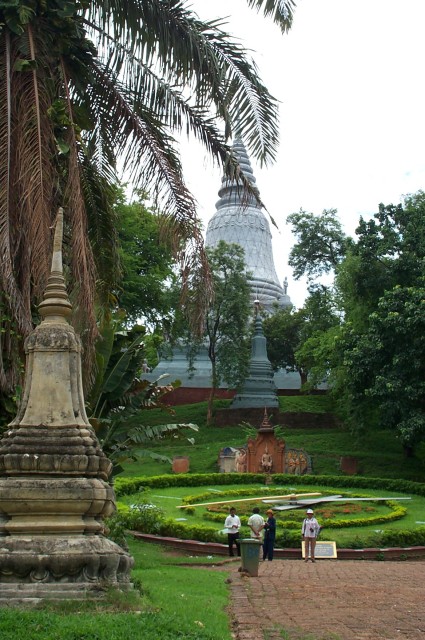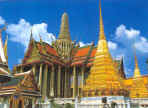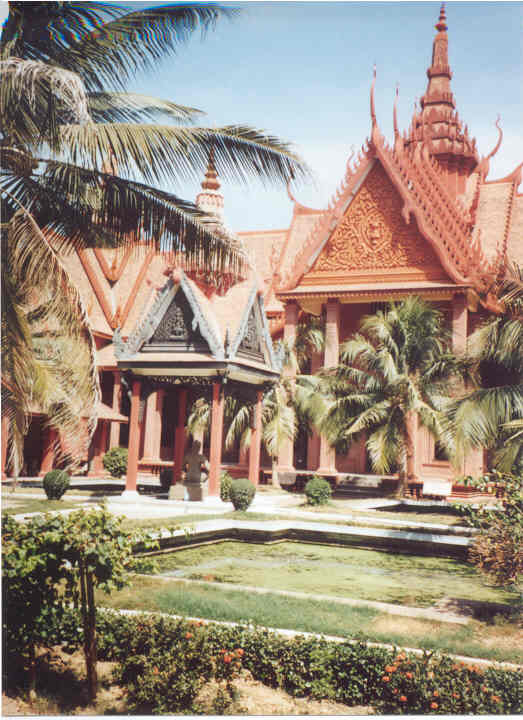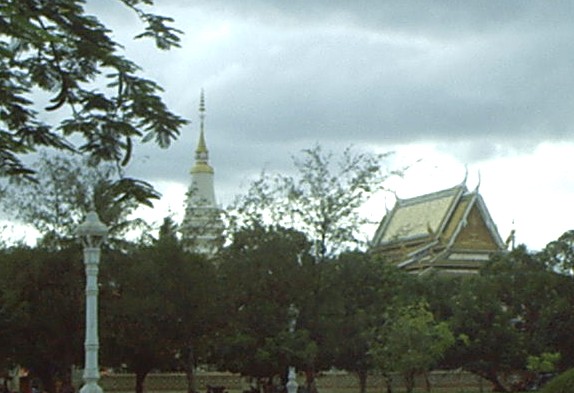| My Travels in South East Asia |
China Vietnam Laos Cambodia Thailand |
Reisverhalen |
Phnom Penh
Dutch
Phnom Penh is situated at the confluence of the Tonle Sap and Bassac rivers with the Mekong. It was founded as a small monastery in 1372 by the rich Khmer woman Penh, after she had found four Buddha statues in a tree trunk on the banks of the Mekong.
She set up the monastery on a hill near the bank of the Mekong. The Cambodian word for hill is Phnom. Therefore the name of the town correctly translates as Hill of Penh.

Rather significantly Phnom Penh's history is founded on an episode, in which the Buddhist religion played a part, contrary to the Khmer capital of that time, Angkor, which was shaped, and literally so, by Hinduism.
Nevertheless, Buddhism had, since the beginning of the 13th century, become the dominant religion.
In Southeast Asia both religions are entwined to a much higher degree than first appears to be the case. For instance, numerous Buddhist temples in Thailand
house altars of Hindu deities, especially Brahma, and the details of the royal ploughing ceremony in Bangkok are determined by Brahman, not Buddhist, palace priests just like Thai coronation modalities).
 In 1434, after the Siamese conquest of Angkor in 1431, the Khmer nobility unwilling to submit to Siamese overlords fled from Angkor and established Phnom Penh as the new Khmer capital, just 64 years after the Buddhist monastery had been founded on Penh Hill. However, the Khmer never succeeded in setting up a new kingdom to come close to the glamour of Angkor.
In 1434, after the Siamese conquest of Angkor in 1431, the Khmer nobility unwilling to submit to Siamese overlords fled from Angkor and established Phnom Penh as the new Khmer capital, just 64 years after the Buddhist monastery had been founded on Penh Hill. However, the Khmer never succeeded in setting up a new kingdom to come close to the glamour of Angkor.
In fact, for long periods of time the Khmer kingdom centered in Phnom Penh wasn't a sovereign country but alternatively a satellite state of, or directly ruled by, the Vietnamese or the Thais.
For more than 400 years - until the French made Cambodia their protectorate - the art of politics in Phnom Penh was just an exercise of balancing between the two powerful neighbours.
On April 17, 1864, the Cambodian king Norodom accepted for his country the status of a French protectorate. King Norodom expected the French to protect Cambodia from the neighbouring countries
Siam (Thailand) and Vietnam.
However, the French protectors did not prevent politically strong Siam from temporarily annexing western parts of the country, including the town of Battambang. Nevertheless, by recognizing French rule, King Norodom preempted moves of Siam and Vietnam to entirely divide his country between them. In past centuries the loss of territory to Vietnam had been more significant. The Mekong delta, or rather the entire present-day South Vietnam, had been settled by Cambodians until well into the 18th century.
During almost 90 years of colonial rule the French reshaped and extended Phnom Penh according to their architectural taste. They built broad boulevards and the city received a touch of Mediterranean atmosphere.
During the Vietnam war the city grew to more than 2 Million inhabitants, creating an atmosphere of an overcrowded refugee camp rather than a French metropolis.
On April 17, 1975, 20 years after the end of French colonial rule, the Khmer Rouge marched into Phnom Penh. Within weeks the city was emptied, its population forced into provincial labour camps; Phnom Penh became a ghost town.
 After an increasing number of incidents at the Cambodian-Vietnamese border, Vietnamese troops move into Cambodia and on January 7, 1979, take Phnom Penh. Since then, many of the city's former inhabitants have returned, and new folks have arrived. The city now, once more, counts over a Million inhabitants.
After an increasing number of incidents at the Cambodian-Vietnamese border, Vietnamese troops move into Cambodia and on January 7, 1979, take Phnom Penh. Since then, many of the city's former inhabitants have returned, and new folks have arrived. The city now, once more, counts over a Million inhabitants.
Since the signing of the Paris Peace Treaty in 1991, Phnom Penh experienced a great economic boom, despite the civil war still smoldering in far-off parts of the country. Although streets and canalization - destroyed by the Khmer Rouge - are not yet fully repaired, a large number of modern hotels have been built.
To Wat Koh
Cambodia Photos
To Kampong Cham

De hoofdstad Phnom Penh lijkt meer op een groot dorp, met veel onverharde wegen, en met de brommer als belangrijkste vervoersmiddel. Leuk om hier te bezoeken zijn de vele markten.
Het Friends-restaurant is tien jaar geleden opgericht door een Fransman die zich het lot van de vele straatkinderen in Phnom Penh aantrok. Alle kinderen die hier terecht komen worden eerst opgeleid en als ze achttien jaar worden dan kunnen ze werken in het restaurant. Naast het restaurant is ook een Friends winkel waar spullen worden verkocht die door de kinderen gemaakt zijn. De opbrengst hiervan gaat naar de school die ernaast ligt. In totaal zijn er zo'n 1200 straatkinderen die hier worden opgevangen en onderwezen om zo een betere toekomst voor zichzelf en hun familie te creŽeren. De jongens worden bijvoorbeeld opgeleid tot kappers, er wordt computerles gegeven en de jongste kinderen krijgen traditionele les in khmerdansen. De organisatie achter het Friends-concept heet Mith Samlanh Friends, en gulle giften zijn zeer welkom! (via Foreign trade Bank of Cambodia, rek. nr. 30-400-808 t.n.v. Mith Samlahn/Friends, met erbij vermeld de SWIFT-code "FTCCKHPP").
Het meeste bezochte museum van Phnom Penh ťn van Cambodja is het Tuol Sleng genocide museum, dat officieel S21 heette. Het is gevestigd in een voormalig schoolgebouw dat tijdens het bewind van de Rode Khmer gebruikt werd als martel- en ondervragingskamp. Van hieruit zijn bijna 20.000 mensen naar het vernietigingskamp Choeung Ek gebracht om geŽxecuteerd te worden: De Killing Fields. Dit hele terrein ligt vol met massagraven, en hier en daar steken er letterlijk botten uit de grond omhoog....
Wat Botum

|
Founded by King Ponyea Yat in the 15th
century, Wat Botum is one of the original Wats in Phnom Penh. It is also
known as the ĎTemple of the Lotus Blossoms' because the original site
was a small island surrounded by a lotus-filled pond. |
This
temple, favoured by the Royal family, is the centre of the Thammayut sect
of Buddhism in Cambodia and is home to one of the country's two
supreme patriarchs, the Venerable Ghosananda. |
Richting het noorden
Elke ochtend vroeg vertrekt er vanaf de kade van Phnom Penh een boot naar het noorden. De bootreis duurt vijf en een half uur en gaat dwars door Cambodja. Als je wilt kun je op je stoel plaats nemen in de boot, maar veel leuker is om met mooi weer op het dek te blijven hangen en gewoon te genieten van wat je allemaal om je heen ziet. Je kan trouwens ook per vliegtuig of per bus naar Siem Reap, maar dit is absoluut de leukste manier. De bootreis vanaf Phnom Penh naar Siem Reap kost 25$. Na vijf en een half uur kom je in de haven aan waar een hele vissersgemeenschap woont. Een half uurtje rijden vanaf de haven ligt Siem Reap, een plek die veel bezoekers trekt vanwege het Ankor tempelcomplex. De duizenden toeristen die elk jaar naar Siem Reap komen, hebben ervoor gezorgd dat hier veel nieuwe hotels staan en elke maand komt er wel een nieuwe bij.
In Siem Reap wonen zo'n 90.000 mensen en de stad wordt echt gezien als de toegang tot de tempels van Ankor. Het is Cambodja's spirituele en culturele hart en de sfeer is heel goed. In Siem Reap zie je ook goed dat ooit de Fransen hier de macht hadden, met prachtige koloniale gebouwen en brede boulevards. En daarnaast wordt je ook met het andere verleden geconfronteerd, het Khmer Rouge verleden; tijdens het Pol Pot regime en de oorlog met Vietnam zijn namelijk miljoenen mijnen door het land verspreid die tot en met de dag van vandaag slachtoffers eist.
Dit land is heel plat en daarom uitstekend te verkennen per fiets. Vanuit Siem Reap worden fietstochten georganiseerd van 1 of meerdere dagen. Een hele leuke manier om de omgeving en te zien.
Voor tickets naar Cambodja via Bangkok kijk je op de site van BudgetAir.

 In 1434, after the Siamese conquest of Angkor in 1431, the Khmer nobility unwilling to submit to Siamese overlords fled from Angkor and established Phnom Penh as the new Khmer capital, just 64 years after the Buddhist monastery had been founded on Penh Hill. However, the Khmer never succeeded in setting up a new kingdom to come close to the glamour of Angkor.
In 1434, after the Siamese conquest of Angkor in 1431, the Khmer nobility unwilling to submit to Siamese overlords fled from Angkor and established Phnom Penh as the new Khmer capital, just 64 years after the Buddhist monastery had been founded on Penh Hill. However, the Khmer never succeeded in setting up a new kingdom to come close to the glamour of Angkor.
 After an increasing number of incidents at the Cambodian-Vietnamese border, Vietnamese troops move into Cambodia and on January 7, 1979, take Phnom Penh. Since then, many of the city's former inhabitants have returned, and new folks have arrived. The city now, once more, counts over a Million inhabitants.
After an increasing number of incidents at the Cambodian-Vietnamese border, Vietnamese troops move into Cambodia and on January 7, 1979, take Phnom Penh. Since then, many of the city's former inhabitants have returned, and new folks have arrived. The city now, once more, counts over a Million inhabitants.

